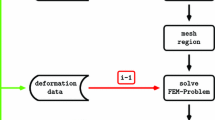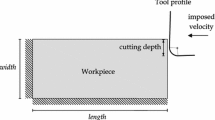Abstract
This work presents the development of the Particle Finite Element Method (PFEM) for the modelling of 3D solid mechanics problems under cutting conditions. The study and analysis of numerical models reproducing the cut of a material is a matter of interest in several areas; namely, the improvement of the material properties, the optimization of the process and tool geometries and the prediction of unexpected failures. The analysis of bi-dimensional (2D) models is the most common approach for different reasons. Just focusing on the simulation point of view, it is the simplest procedure, the cheapest in terms of computational cost and sometimes the only feasible numerical solution. However, many industrial machining processes, such as cutting, blanking, milling and drilling have not a possible simplification to 2D models. Actually even a simple turning processes for non-orthogonal cuts can not be simplified to 2D. This work present an upgrade of the PFEM techniques in order to deal with the 3D machining problems. We present recent improvements in the finite element formulation, the meshing re-connections and the contact detection. By applying these developments the PFEM has the capability for modelling a wide range of practical machining processes. In this paper the capacity of the formulation and the accuracy of the results are analyzed and validated with some representative examples.




















Similar content being viewed by others
References
Belytschko T, Liu WK, Moran B (2000) Nonlinear finite element for continua and structures. Wiley, England
Bonet J, Wood RD (1997) Nonlinear continuum mechanics for finite element analysis. Cambridge University Press, United Kingdom
Chiumenti M, Valverde Q, Agelet de Saracibar C, Cervera M (2004) A stabilized formulation for incompressible plasticity using linear triangles and tetrahedra. Int J Plast 20:1487–1504
Bochev PB, Dohrmann CR, Gunzburger MD (2008) Stabilization of low-order mixed finite elements for the stokes equations. SIAM J Numer Anal 44:82–101
Calvo N, Idelsohn S, Onate E (2003) The extended Delaunay tellesation. Engineering Computations: Int J for Computer-Aided Engineering 20:583–600
Carbonell JM (2009) Modeling of ground excavation with the particle finite element method. PhD thesis, Universitat Politècnica de Catalunya (UPC), Barcelona
Carbonell JM, Oñate E, Suárez B (2009) Modeling of ground excavation with the particle finite-element method. J Eng Mech 136:455–463
Carbonell JM, Oñate E, Suárez B (2013) Modelling of tunnelling processes and rock cutting tool wear with the particle finite element method. Comput Mech 52:607–629
Delaunay BN (1934) Sur la Sphère Vide, A la memoire de Georges Voronoi. Otdelenie Matematicheskii i Estestvennyka Nauk 7:793–800
Dohrmann CR, Bochev PB (2004) A stabilized finite element method for the Stokes problem based on polynomial pressure projections. Int J Numer Methods Fluids 46:183–201
Idelsohn SR, Oñate E, Del Pin F (2004) The particle finite element method: a powerful tool to solve incompresible flows with free-surfaces and breaking waves. Int J Numer Methods Eng 61:964–989
Joe B, Wang CA (1993) Duality of constrained voronoi diagrams and delaunay triangulations. Algorithmica 9 4:142–155
Johnson GR, Cook WH (1983) A constitutive model and data for metals subjected to large strains, high strain rates and high temperatures. In: Proceedings of 7th international symposium on ballistics, Hague, Netherlands, pp 1–7
Oliver J, Cante JC, Weyler R, González C, Hernández J (2007) Particle finite element methods in solid mechanics problems. Comput Methods Appl Sci 7:87–103
Oñate E, Idelsohn SR, Del Pin F, Aubry F (2004) The particle finite element method: an overview. Int J Numer Methods Eng 1(2):964–989
Oñate E, Celigueta MA, Idelsohn SR (2006) Modeling bed erosion in free surface flows by the particle finite element method. Acta Geotech 1:237–252
Oñate E, Idelsohn SR, Celigueta MA, Rossi R (2008) Advances in the particle finite element method for the analysis of fluid multibody interaction and bed erosion in free surface flows. Comput Methods Appl Mech Eng 197:1777–1800
Oñate E, Franci A, Carbonell JM (2013) Lagrangian formulation for finite element analysis of quasi-incompressible fluids with reduced mass losses. Int J Numer Methods Fluids 74:699–731
Oñate E, Franci A, Carbonell JM (2014) A particle finite element method for analysis of industrial forming processes. Comput Mech 54:85–107
Marusich TD, Ortiz M (1995) Modelling and simulation of high-speed machining. Int J Numer Methods Eng 38:3675–3694
Rodríguez JM (2014) Numerical modeling of metal cutting processes using the particle finite element method(PFEM). PhD thesis, Universitat Politècnica de Catalunya (UPC), Barcelona
Rodríguez JM, Cante JC, Oliver J (2015) On the numerical modelling of machining processes via the particle finite Element method (PFEM). CIMNE: Barcelona 156:186
Rodríguez JM, Carbonell JM, Cante JC, Oliver J (2016) The particle finite element method (PFEM) in thermo-mechanical problems. Int J Numer Methods Eng. https://doi.org/10.1002/nme.5186
Rodríguez JM, Jonsén P, Svoboda A (2017) Simulation of metal cutting using the particle finite-element method and a physically based plasticity model. Comput Particle Mech 4:35–51 Wiley
Rodríguez JM, Jonsén P, Svoboda A (2016) A particle finite element method for machining simulations. In: Papadrakakis M, Papadopoulos V, Stefanou G, Plevris V (eds) ECCOMAS congress: 2016 VII European congress on computational methods in applied sciences and engineering, Crete island, Greece, vol 1. National Technical University of Athens, Athens, pp 539–553
Rodríguez JM, Carbonell JM, Cante JC, Oliver J (2017) Continuous chip formation in metal cutting processes using the particle finite element method (PFEM). Int J Solids Struct 120:81–102
Rodríguez JM, Carbonell JM, Cante JC, Oliver J, Jonsén P (2017) Generation of segmental chips in metal cutting modeled with the PFEM. Comput Mech 1:1–17
Rodríguez JM, Carbonell JM, Jonsén P (2020) Numerical methods for the modelling of chip formation. Arch Comput Methods Eng SP - 387 27:387–412
Shewchuk JR (1998) A condition guaranteeing the existence of higher-dimensional constrained Delaunay triangulations. Proceedings of the fourteenth annual symposium on computational geometry. ACM, Minneapolis, MN, USA, pp 76–85
Simo JC (1988) A framework for finite strain elastoplasticity based on maximum plastic dissipation and the multiplicative decomposition: part I. continuum formulation. Comput Methods Appl Mech Eng 666:199–219
Simo JC (1988) A framework for finite strain elastoplasticity based on maximum plastic dissipation and the multiplicative decomposition: Part II. Computational aspects. Comput Methods Appl Mech Eng 68:1–31
Simo JC, Miehe C (1992) Associative coupled thermoplasticity at finite strains: formulation, numerical analysis and implementation. Comput Methods Appl Mech Eng 98:41–104
Simo JC, Hughes TJR (1998) Computational inelasticity. Springer, New York
Voce E (1955) A practical strain hardening function. UK Metall Br J Metals 51:219–226
Svoboda A, Wedberg D, Lindgren L-E (2010) Simulation of metal cutting using a physically based plasticity model. Model Simul Mater Sci Eng 18(7):075005 pp. 1-19
Lee W-S, Lin C-F (1998) High-temperature deformation behaviour of Ti6Al4V alloy evaluated by high strain-rate compression tests. J Mater Process Technol 75(1):127–136
Rojek J, Oñate E, Taylor RL (2006) CBS-based stabilization in explicit solid dynamics. Int J Numer Methods Eng 66:1547–1568
Bonet J, Burton AJ (1998) A simple average nodal pressure tetrahedral element for incompressible and nearly incompressible dynamic explicit applications. Commun Numer Methods Eng 14:437–449
De Micheli PO, Mocellin K (2009) A new efficient explicit formulation for linear tetrahedral elements non-sensitive to volumetric locking for infinitesimal elasticity and inelasticity. Int J Numer Methods Eng 79:45–68
Ibrahimbegovic A, Chorfi L (2002) Covariant principal axis formulation of associated coupled thermoplasticity at finite strains and its numerical implementation. Int J Solids Struct 39:499–528
Tadi Beni Y, Movahhedy MR (2010) Consistent arbitrary Lagrangian Eulerian formulation for large deformation thermo-mechanical analysis. Int J Solids Struct Mater Des 31:3690–3702
Edelsbrunner H, Mucke EP (1994) Three dimensional alpha shapes. ACM Trans Graph 13:43–72
Zienkiewicz OC, Zhu JZ (1992) The superconvergent patch recovery and a posteriori error estimates. Part 1: The recovery technique. Int J Numer Methods Eng 33:1331–1364
Zienkiewicz OC, Zhu JZ (1992) The superconvergent patch recovery and a posteriori error estimates. Part 2: error estimates and adaptivity. Int J Numer Methods Eng 33:1365–1382
Acknowledgements
We would like to acknowledge Professor Pär Jonsén and the Division of Solid Mechanics of the Luleå Tekniska Universitet (LTU) for the support given to our investigations. The authors Josep Maria Carbonell and Eugenio Oñate acknowledge financial support from the Spanish Ministry of Economy and Competitiveness, through the “Severo Ochoa Programme for Centres of Excellence in R&D” (CEX2018-000797-S).
Author information
Authors and Affiliations
Corresponding author
Ethics declarations
Declarations
Not applicable.
Additional information
Publisher's Note
Springer Nature remains neutral with regard to jurisdictional claims in published maps and institutional affiliations.
Rights and permissions
About this article
Cite this article
Carbonell, J.M., Rodríguez, J.M. & Oñate, E. Modelling 3D metal cutting problems with the particle finite element method. Comput Mech 66, 603–624 (2020). https://doi.org/10.1007/s00466-020-01867-5
Received:
Accepted:
Published:
Issue Date:
DOI: https://doi.org/10.1007/s00466-020-01867-5




